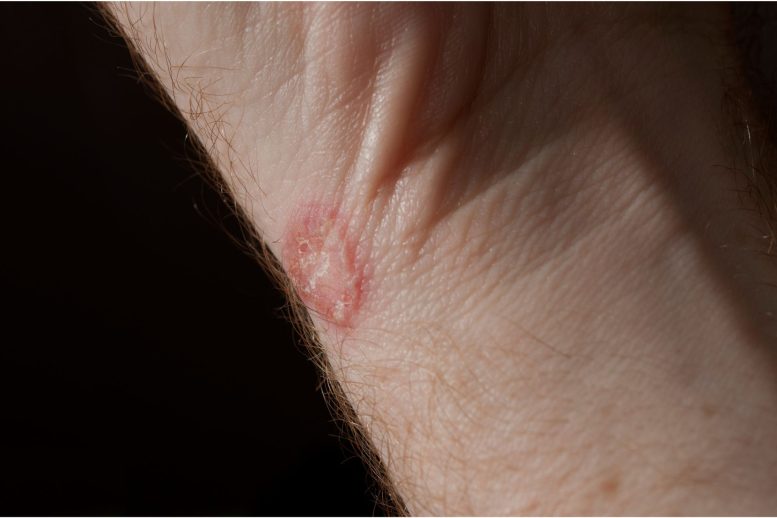
Healthcare professionals are alerted to the emergence of highly contagious fungal infections, such as ringworm and jock itch, with two recent studies highlighting cases resistant to standard treatments. The first study reports a sexually transmitted fungal infection, TMVII, that has been challenging to treat and slow to resolve but responsive to typical antifungal medications. The second study involves a different fungus, T. indotineae, which often resists conventional treatments but has shown some responsiveness to an alternative medication, itraconazole, despite potential side effects. Researchers emphasize the importance of recognizing these infections’ atypical presentations to avoid misdiagnosis and inadequate treatment.
Healthcare professionals are warned of emerging, highly contagious fungal infections, including sexually transmitted and drug-resistant strains, which may be misdiagnosed due to their atypical presentation.
Healthcare providers need to be vigilant for emerging and highly infectious types of ringworm and jock itch, which pose a potential public health risk according to a pair of reports.
In the first of the studies, experts at NYU Langone Health who focus on the spread of contagious rashes document the first reported U.S. case of a sexually transmitted fungal infection that can take months to clear up even with treatment. In the second report, NYU Langone physicians partnered with authorities at the New York State Department of Health to describe the largest group of patients in the country with a similar fungal strain that resists standard therapies.
Characteristics of the Fungal Infections
Both species of fungi are among a group that causes skin rashes, or tinea, that easily spread on the face and limbs (ringworm), groin (jock itch), and feet (athlete’s foot). However, the tinea explored in the new reports can look very different from the neat, regular circles seen in most forms of ringworm. They may instead be confused for lesions caused by eczema and can therefore go without proper treatment for months.
The first report, publishing online on June 5 in the journal JAMA Dermatology, describes a man in his 30s who developed tinea on his penis, buttocks, and limbs after returning home to New York City from a trip to England, Greece, and California. Genetic tests of fungal samples collected from the patient’s rashes revealed that the infection was caused by the species Trichophyton mentagrophytes type VII (TMVII). This sexually transmitted form of ringworm has been increasingly diagnosed throughout Europe, with 13 instances reported in France in 2023, mostly in men who have sex with men. Notably, the man in the current study said he had sex with multiple male partners during his travels, none of whom reported similar skin issues.
Advice from Healthcare Experts
“Healthcare providers should be aware that Trichophyton mentagrophytes type VII is the latest in a group of severe skin infections to have now reached the United States,” said study lead author and dermatologist Avrom Caplan, MD. Caplan is an assistant professor in the Ronald O. Perelman Department of Dermatology at NYU Grossman School of Medicine.
“Since patients are often reluctant to discuss genital problems, physicians need to directly ask about rashes around the groin and buttocks, especially for those who are sexually active, have recently traveled abroad, and report itchy areas elsewhere on the body,” added study senior author John Zampella, MD.
Zampella, an associate professor in the Ronald O. Perelman Department of Dermatology at NYU Grossman says that while infections caused by TMVII are difficult to treat and can take months to clear up, they so far appear to respond to standard antifungal therapies such as terbinafine.
Meanwhile, Caplan says the new skin condition explored in his other new report presents a greater challenge for dermatologists. The study results, published online in May in JAMA Dermatology, center on Trichophyton indotineae (T. indotineae), which is widespread in India and is now reported globally. First confirmed to be in the U.S. last year, the infection causes similar itchy and contagious rashes as TMVII but often resists terbinafine treatment.
Study Findings on Drug Resistance
To better understand how T. indotineae can evade antifungal drugs, the researchers collected clinical and laboratory data from 11 men and women treated for ringworm in New York City hospitals between May 2022 and May 2023. Their tinea was confirmed to have been caused by T. indotineae. Seven of the patients had received standard doses of terbinafine for anywhere from 14 days (the usual duration for most forms of ringworm) to 42 days, yet their rashes did not improve.
Analyzing the fungal samples’ DNA, the team reported several variations in the genetic code (mutations) that prevent terbinafine from hooking onto fungal cells and poking holes in their protective membranes. According to the study authors, these mutations might help explain why the therapy often failed in some cases to fight the infections.
The results also showed that when seven patients were treated with another antifungal called itraconazole, three recovered entirely and two improved. The problem with this therapy however, Caplan says, is that while effective, the drug can interfere with many medications and can cause nausea, diarrhea, and other side effects that make it hard to use for long periods.
“These findings offer new insight into how some of the fungal skin infections spreading from South Asia can evade our go-to therapies,” said Caplan. “Beyond learning to recognize their misleading signs, physicians will need to ensure their treatment addresses each patient’s quality-of-life needs.”
Caplan adds that he plans to work with leading fungi experts around the U.S. and internationally over the next few months to expand research efforts and track emerging cases.
The researchers caution that while dermatologists should be on the alert for signs of TMVII and T. indotineae in their patients, rates so far remain low in the U.S.
References: “Potential Sexual Transmission of Tinea Pubogenitalis From TMVII” by Avrom S. Caplan, Michelle Sikora, Arianna Strome, Christine C. Akoh, Caitlin Otto, Sudha Chaturvedi and John G. Zampella, 5 June 2024, JAMA Dermatology.
DOI: 10.1001/jamadermatol.2024.1430
“Clinical Course, Antifungal Susceptibility, and Genomic Sequencing of Trichophyton indotineae” by Avrom S. Caplan, Gabrielle C. Todd, YanChun Zhu, Michelle Sikora, Christine C. Akoh, Jeannette Jakus, Shari R. Lipner, Kayla Babbush, Karen P. Acker, Ayana E. Morales, Rebecca M. Marrero Rolón, Lars F. Westblade, Maira Fonseca, Abigail Cline, Jeremy A. W. Gold, Shawn R. Lockhart, Dallas J. Smith, Tom Chiller, William G. Greendyke, Swati R. Manjari, Nilesh K. Banavali and Sudha Chaturvedi, 15 May 2024, JAMA Dermatology.
DOI: 10.1001/jamadermatol.2024.1126
Study funding was provided by NYU Langone.









I have it on my palms. It started three years ago. 12 drs have not been able to help. Saying eczema BUT it’s just not the way it started I have documented blisters patches, continuously dry shin and red and non itchy scaly skin.
Please email me as I have questions on similar problem does it go away then come back get worse when wet?
I remember as a kid getting ring worm from a cat on my hand and my aunt and mom put clear finger nail polish on it . It stung for a second but it went away.
Patent number 5571-535
Look I stumbled on to a way to see these thing with a phone Pic and every person shows these parasites and there not natural.